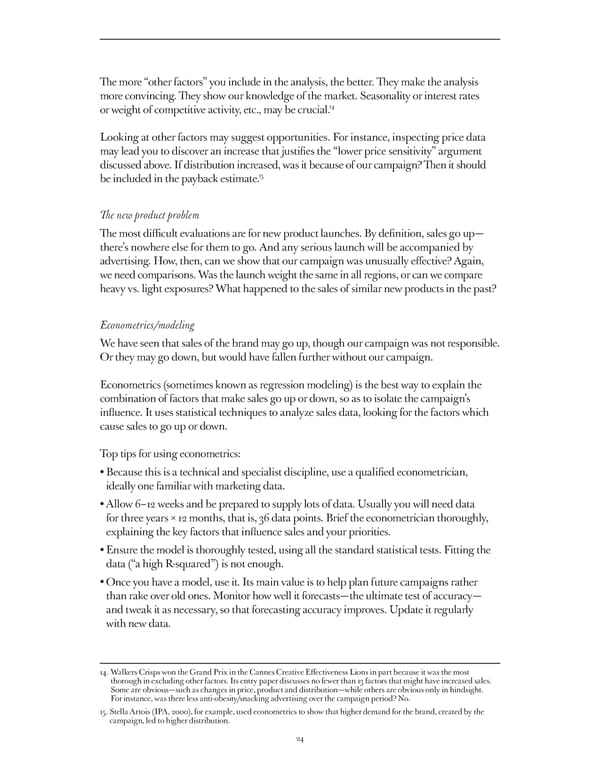The more “other factors” you include in the analysis, the better. They make the analysis more convincing. They show our knowledge of the market. Seasonality or interest rates 14 or weight of competitive activity, etc., may be crucial. Looking at other factors may suggest opportunities. For instance, inspecting price data may lead you to discover an increase that justifies the “lower price sensitivity” argument discussed above. If distribution increased, was it because of our campaign? Then it should 15 be included in the payback estimate. The new product problem The most difficult evaluations are for new product launches. By definition, sales go up — there’s nowhere else for them to go. And any serious launch will be accompanied by advertising. How, then, can we show that our campaign was unusually effective? Again, we need comparisons. Was the launch weight the same in all regions, or can we compare heavy vs. light exposures? What happened to the sales of similar new products in the past? Econometrics/modeling We have seen that sales of the brand may go up, though our campaign was not responsible. Or they may go down, but would have fallen further without our campaign. Econometrics (sometimes known as regression modeling) is the best way to explain the combination of factors that make sales go up or down, so as to isolate the campaign’s influence. It uses statistical techniques to analyze sales data, looking for the factors which cause sales to go up or down. Top tips for using econometrics: • Because this is a technical and specialist discipline, use a qualified econometrician, ideally one familiar with marketing data. • Allow 6 – 12 weeks and be prepared to supply lots of data. Usually you will need data for three years × 12 months, that is, 36 data points. Brief the econometrician thoroughly, explaining the key factors that influence sales and your priorities. • Ensure the model is thoroughly tested, using all the standard statistical tests. Fitting the data (“a high R-squared”) is not enough. • Once you have a model, use it. Its main value is to help plan future campaigns rather than rake over old ones. Monitor how well it forecasts — the ultimate test of accuracy — and tweak it as necessary, so that forecasting accuracy improves. Update it regularly with new data. 14. Walkers Crisps won the Grand Prix in the Cannes Creative Effectiveness Lions in part because it was the most thorough in excluding other factors. Its entry paper discusses no fewer than 13 factors that might have increased sales. Some are obvious — such as changes in price, product and distribution — while others are obvious only in hindsight. For instance, was there less anti-obesity/snacking advertising over the campaign period? No. 15. Stella Artois (IPA, 2000), for example, used econometrics to show that higher demand for the brand, created by the campaign, led to higher distribution. 24
 A Guide To Effectiveness Page 23 Page 25
A Guide To Effectiveness Page 23 Page 25